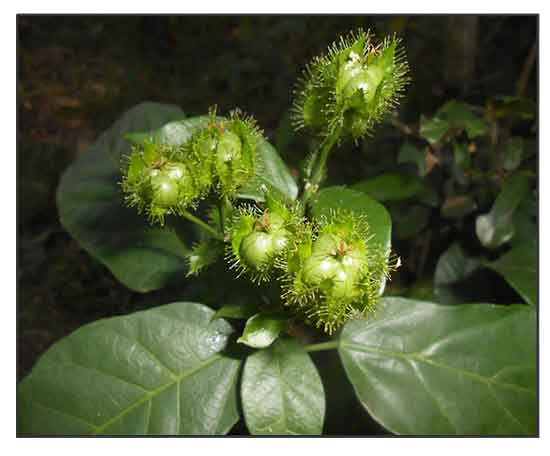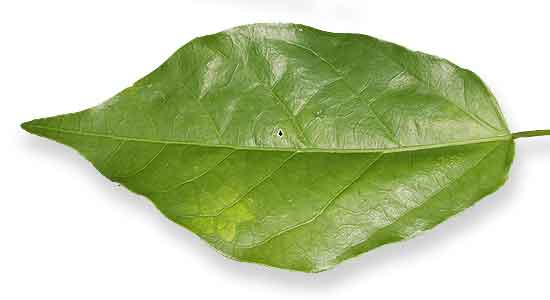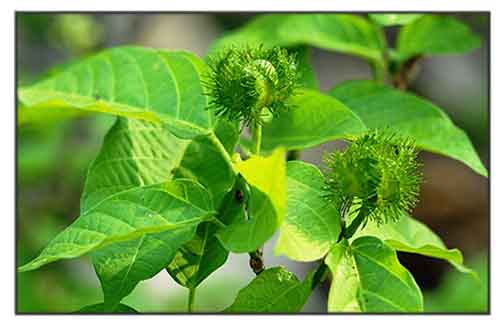Gen info
- Strophioblachia is a genus of plants in the family Euphorbiaceae, first described as a genus in 1900. It contains only one known species, Strophioblachia fimbricalyx.
 Botany Botany
• Small shrub to treelet, up to 2 m high, dbh up to 5 cm; flowering branches 1.5–3 mm thick, smooth, glabrescent. Bark rough. Leaves: petiole 0.5–7 cm long, glabrous to pilose, glabrescent; blade 6–19 by 1.3–9.5 cm, index 2–2.3, glabrous to subpilose and glabrescent on lower surface, venation flat above, raised below, nerves 6 or 7 per side between footnerves and apical sinus. Inflorescences up to 7 cm long, axes green. Bractsup to 13 by 2.5 mm. Staminate flowers 4–4.5 mm in diam.; pedicel 5–20 mm long, subpilose; sepals 3–4 by 2–3.5 mm, (green to) cream-white, glabrous when older; petals (0–)1–2.8 by (0–)1.2–3.8 mm; disc lobes 0.7–1.2 by 0.3–0.8 mm; stamens white to light yellow, filaments 1.8–2.8 mm long, anthers 0.3–0.6 by 0.3–0.5 mm. Pistillate flowers 5–15 mm in diam.; pedicel up to 13 mm long; sepals and fimbriae green to pale yellow, blade 4–8.5 by 2.8–4 mm, fimbriae up to 1 mm long; (petals ovate to elliptic, c. 4.5 by 2 mm); ovary 1.2–2 by 1.7–2 mm; style 0.9–2 mm long, stigmas 2.5–4.5 mm long, united in lower 0.5–1.4 mm. Fruit 11–13 by 8–10 mm, dark brown when dry, (dark) green when fresh, wall less than 1 mm thick; pedicel up to 23 mm long; sepals 12–15 by 7.5–10 mm with the fimbriae up to 4.2 mm long; column after dehiscence 6.5–7 mm long. Seeds ± globose, 6–7 by 5.5–6 by 4.5–5 mm. (2)
Distribution
- Native to the
Philippines. (1) (3)
- In secondary and edges of primary semi-deciduous forests, thickets near the seashore. On rocky, calcareous and sandy soils. Flowers throughout the year, although less in November to January. (3)
-
Also native to Cambodia, China South-Central, China Southeast, Hainan, Sulawesi, Thailand, Vietnam. (1)
 Constituents Constituents
- Study isolated 13 phenylpropanoid glycosides, including six lignans (1-6), four coumarins (7-10), and three phenylpropanoid glycosides (11-13). The lignans presented different structural types, such as benzofuran, furofuran, biphenyl and hybrid lignans. Chemotaxonomic significance was discussed. (4)
- Study of roots yielded the known compound, trigonosterone (1), together with three new compounds, 9-O-demethyltrigonostemone (2), 3,6,9-trimethoxyphenantropolone (3) and 4,6,9-trimethoxyphenan-tropolone (4). (see study below) (6)
- Study of roots isolated 8 new compounds, fimbricalyxs B-D (1-3), fimbricaly-xanhydrides A and B (4,5) and fimbricalyxlactones A-C (6-8), together wiith 3 known compounds, trigonostemone (9), 3,6,9-trimethoxyphenanthropolone (10), and fimbricalyx A (11).
(see study below) (8)
- Study of aerial parts isolated three megastigmane glucosides,
bridelionoside B, ampelopsisionoside and 3-hydroxy-5,6-epoxy-β-ionol 9-O-β-d-glucopyranoside, together with three flavone glycosides, apigenin 7-O-β-d-glucopyranoside, isovitexin and spinosin. (9)
- Nutrient analysis of shoot tips revealed protein (6.13 g/100g fresh weight
) and fiber (2/07 g/100g fw) as highest contents, and lipid (0.10 g/100g fw) as lowest. Trace elements with highest concentrations are iron (5.32 mg/100g fw), selenium (14.80 ug/100g fw) and zinc (1.37 mg/100g fw). Vitamin C was low at 1.54 mg/100 g fw, and beta-carotene at 0.51 mg/100g. (11)
- Study of leaves and stems isolated two new norneolignans, fimbricalyxinlignan A and B (1,2), together with four known compounds (3-6). (14)
Properties
- Studies have suggested anti-cardiac hypertophic, cytotoxic, anticancer, antiplasmodial, antibacterial, nutrient, potential AChE inhibition properties.
Parts used
Leaves, roots, stems, seeds.
 Uses Uses
Edibility
- In Mindoro, dry seeds are used in fermented drinks.
Folkloric
- No reported folkloric medicinal use in the Philippines.
- In Thailand, decoction of plant used for the treatment of Migraine headaches. Roots combined with other medicinal plants used as aqueous decoction to treat fevers. Fermented liquor of roots together with other medicinal plants used for treatment of cancer. (6)
- In China, ethnic Dai people use roots for treatment of migraine, fever, and cancer. (12)
Studies
• Anticardiac Hypertrophic Inhibitory Activity / Strophioblachins Diterpnoids / Aerial Parts: Study isolated three new rearranged diterpenoids, strophioblachins A-C (1-3), eight new diterpenoids, strophioblachins D-K (4-11), and seven known diterpenoid (12-18), purified from aerial parts of S. fimbricalyx. On testing for cardiac hypertrophic activity, compounds 10 and 15 dose-dependently lowered the mRNA expression of Nppa and Nppb. Protein levels confirmed by Western blotting, showed both compounds lowered the expression of the hypertrophic marker ANP. The compounds also showed weak cytotoxic activity against neonatal rat cardiomyocytes assayed in vitro by CCK-8 and ELISA methods.
(5)
• Anticancer / Antiplasmodial / Roots: Study of roots yielded the known compound, trigonosterone (1), together with three new compounds, 9-O-demethyltrigonostemone (2), 3,6,9-trimethoxyphenan-tropolone (3) and 4,6,9-trimethoxyphenan-tropolone (4). Compound 2 showed interesting cytotoxicity against NCI-H187, KB, and MCF7 cancer cell lines. Compounds 2 and 3 exhibited in-vitro antiplasmodial activity (IC50 2.7 and 3.2 µg/mL, respectively) against Plasmodium falciparum (K1, resistant strain). Continued search for new compounds identified compound 6, fimbricalyx B, which exhibited potent antiplasmodial activity with IC50 of 0.019 mM. (6)
• Cytotoxic Activity by Apoptosis Induction / Leaves and Stems: Study of leaves and stems isolated a group of phenanthrene derivatives (1-4), an umdescribed natural product (5), and five known compounds (6-10). All isolates were evaluated for cytotoxic activity against three tumor cell lines, and compounds 8 and 10 showed significant activity with IC50s of 4.65 to 9.02 µM. Trigohowilol G, compound 10, showed stronger cytotoxic activity by inhibition of A549 proliferation, which may be related to cell cycle distribution and induction of S phase arrest, and induction of cell apoptosis through Bad/Bax/cleaved PARP1 pathway. (7)
• Antiplasmodial / Cytotoxicity / Roots: Study of roots isolated 8 new compounds, fimbricalyxs B-D (1-3), fimbricalyxanhydrides A and B (4,5) and fimbricalyxlactones A-C (6-8), together with 3 known compounds, trigonostemone (9), 3,6,9-trimethoxyphenanthropolone (10), and fimbricalyx A (11). Fimbricalyx B (1) exhibited potent antiplasmodial activity with IC50 of 0.019 µM, while compound 4 exhibited cytotoxicity toward NCI-H187 cancer cells and antiplasmodial activities with IC50s of 5.7 and 3.9 µM, respectively. (8)
• Antibacterial / Trigonostemone / Roots: Study of hexane fraction of roots isolated 3-acetylaleuritolic acid, trigonostemone and 3,6,9-trimethoxyphenanthropolone. The isolated compounds were evaluated for antibacterial activity toward pathogenic Gram(+) and Gram(-) bacteria. Among the isolated compounds, trimethoxyphenanthropolone was the only active one, exhibiting inhibitory effect on the growth of Gram(+) bacteria, methicillin-susceptible Staphylococcus aureus (MSSA) DMST 20933, MRSA DMST 20651 and Bacillus aureus ATCC 11778 with MIC/MBCs of 12.5/25.0, 6.25/6.25, and 6.25/6.25 mg/mL respectively. Results suggest trigonostemone has potential for use as a natural antibacterial compound against S. aureus MSSA DMST 2933 and B. cereus ATCC 11778 strains. (10)
• Cytotoxicity Against Human Tumor Cell Lines / Leaves and Stems: Study of leaves and stems identified 5 new compounds, namely fimbricalyxoids A–D (1–4) and 13-O-methylfimbricalyx B (5), together with five known compounds, 12-hydroxy-13-methylpodocarpa-9,11,13-trien-3-one (6), trigonostemon (7), limettin (8),5-methoxy-7-hydroxycoumarin (9), and sonderianol (10). Compounds 1, 6, and 7 exhibited cytotoxicity against five human tumor cell lines. (12)
• Strophioblin / Dinor-Diterpenoid / Potential AChE Inhibition
/ Leaves and Stems: Study of leaves and stems isolated a novel dinor-diterpenoid, named strophioblin. Molecular docking studies indicated it may have potential AChE inhibition. (13)
Availability
- Wild-crafted.
|

![]()




 Constituents
Constituents
